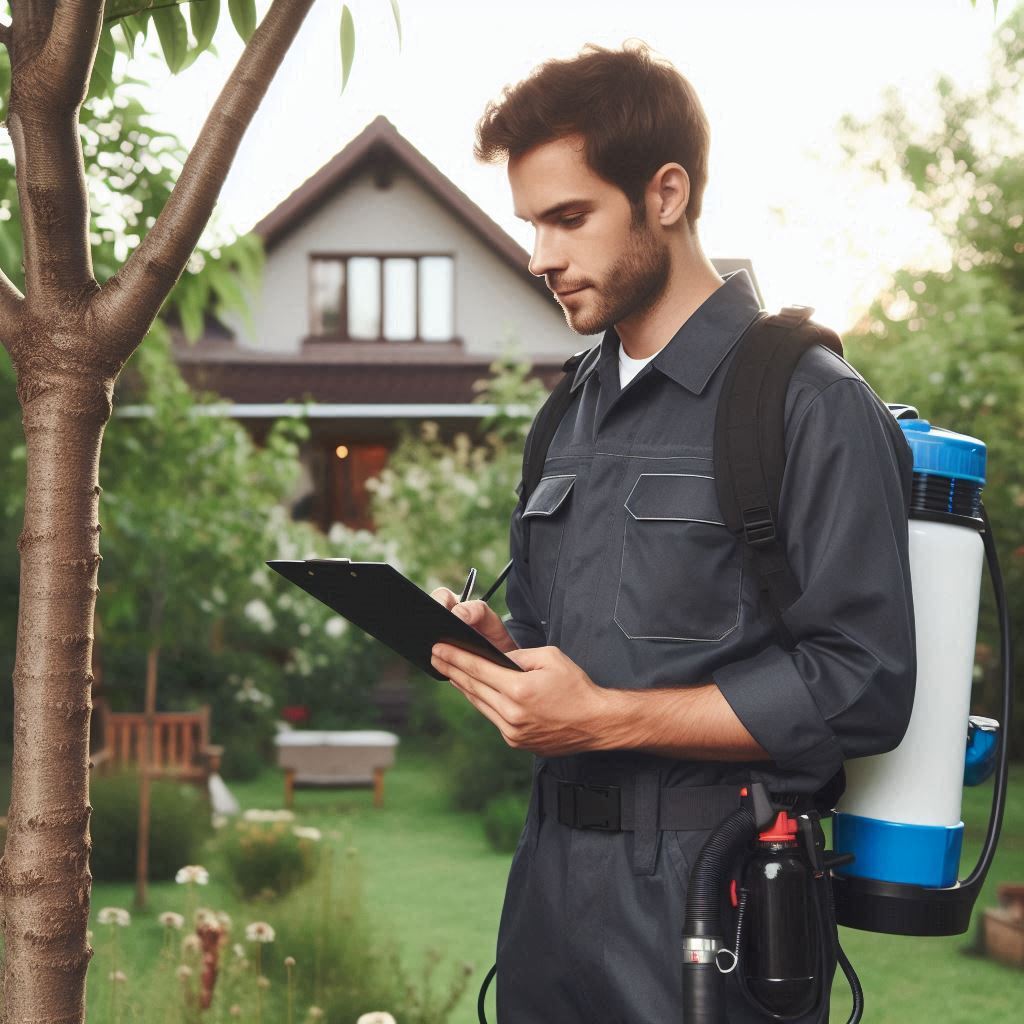Introduction
Pest control plays a critical role in maintaining a healthy and comfortable living environment.
Without effective pest management, infestations can spread, causing health risks and property damage.
Two key professionals in this field are pest control workers and exterminators.
Roles of Pest Control Workers and Exterminators
Both pest control workers and exterminators handle pest problems, but their approaches differ:
- Pest Control Workers: Focus on long-term prevention by identifying pest sources and applying treatments to reduce future infestations.
- Exterminators: Provide immediate solutions to eliminate pests, often using chemicals to quickly address severe infestations.
Key Differences Between Pest Control Workers and Exterminators
Understanding their differences helps in choosing the right service:
- Scope of Work: Pest control workers offer ongoing services, while exterminators focus on short-term eradication.
- Methods: Pest control workers use integrated pest management (IPM) strategies, while exterminators rely more on chemical treatments.
- Focus: Pest control aims at prevention and control, while exterminators prioritize rapid elimination.
This blog will explore these roles in detail, helping you choose the right professional based on your pest management needs.
Job Responsibilities of a Pest Control Worker
A pest control worker plays a crucial role in managing and preventing pest infestations in homes, businesses, and public spaces.
Their primary responsibilities include inspecting properties, applying pest control treatments, and educating clients on how to prevent future infestations.
Here’s a closer look at what a pest control worker does on the job:
Conducting Inspections
A pest control worker begins by inspecting properties to identify pests.
They thoroughly examine potential hiding places like cracks, crevices, and hidden corners.
Once pests are identified, they assess the extent of the infestation.
This critical step helps determine the best course of action for eliminating pests.
Implementing Pest Control Measures
After the inspection, the pest control worker uses various methods to address the infestation.
Common pest control techniques include:
- Setting traps for rodents and insects
- Applying pesticides safely to affected areas
- Sealing entry points to block further pest access
Each method is tailored to the specific type of pest and the severity of the infestation.
These actions ensure pests are eliminated quickly and effectively.
Educating Customers on Prevention
Pest control workers also teach customers how to prevent future infestations.
They offer advice on keeping homes and businesses clean, sealing potential entry points, and eliminating food and water sources.
These tips empower customers to maintain pest-free environments.
Transform Your Career Today
Unlock a personalized career strategy that drives real results. Get tailored advice and a roadmap designed just for you.
Start NowMonitoring and Assessing Treatment Effectiveness
To ensure the pest control measures are working, the worker regularly returns to the site.
They monitor the situation to verify the treatment’s effectiveness.
If the problem persists, they adjust their approach and may apply additional treatments.
Continuous monitoring helps maintain long-term pest control.
The job of a pest control worker requires a mix of technical knowledge and problem-solving skills.
By conducting thorough inspections, implementing tailored pest control methods, educating clients, and regularly assessing treatment effectiveness, pest control workers play a vital role in protecting homes and businesses from pests.
These responsibilities ensure clients can live and work in pest-free environments, maintaining both safety and comfort.
Read: How to Handle Emergency Situations in Pet Grooming
Job Responsibilities of an Exterminator
Exterminators play a vital role in safeguarding homes and businesses from pest invasions.
Their primary responsibility is eliminating existing pest infestations.
To achieve this, exterminators use specialized tools, chemicals, and advanced techniques that target specific types of pests.
Their goal is to eradicate pests quickly and effectively, ensuring the safety and comfort of their clients.
Specializing in the Elimination of Existing Pest Infestations
Exterminators are experts in identifying and eliminating pests that have already invaded a property.
They inspect affected areas, determine the extent of the infestation, and take immediate action to eliminate the pests.
Their training allows them to spot even the most hidden infestations, ensuring no pests are left behind.
Using Advanced Techniques and Chemicals
Exterminators rely on cutting-edge pest control methods to remove pests.
This involves using modern tools, techniques, and powerful chemicals that work efficiently.
Some of the common methods exterminators use include:
- Chemical sprays and powders
- Bait stations and traps
- Heat treatments
- Fumigation
These techniques are carefully chosen based on the type of pest and the level of infestation.
Providing Targeted Treatments for Specific Pests
Each pest requires a unique approach for effective elimination.
Transform Your Career Today
Unlock a personalized career strategy that drives real results. Get tailored advice and a roadmap designed just for you.
Start NowExterminators tailor their treatments to target specific pests such as ants, cockroaches, termites, rodents, or bed bugs.
They ensure the right treatment is applied for each pest, reducing the risk of recurrence.
This tailored approach increases the effectiveness of pest control efforts.
Offering Follow-up Services
Effective pest control doesn‘t end with a single visit.
Exterminators provide follow-up services to ensure pests are completely eradicated.
These follow-up visits allow exterminators to monitor the situation, retreat areas if necessary, and give clients peace of mind that the problem has been fully addressed.
Exterminators work efficiently to eliminate pests and prevent their return, ensuring homes and businesses remain pest-free for the long term.
Read: How Much Do Pet Groomers Earn in the USA?
Training and Certification Requirements for Pest Control Workers
To become a pest control worker, candidates must meet specific training and certification requirements.
Completion of a State-Approved Training Program in Pest Control
The first step involves completing a state-approved training program in pest control.
These programs provide essential knowledge about pest identification, biology, and control methods.
Participants learn about different pests, their behaviors, and the best practices for managing infestations.
This foundational training equips workers with the skills necessary to perform their jobs effectively.
Obtaining a Pesticide Applicator License or Certification
After completing the training program, prospective pest control workers must obtain a pesticide applicator license or certification.
Each state has its own licensing requirements, so candidates should check their local regulations.
Typically, this process involves passing a written exam.
The exam assesses knowledge of pesticide application, safety measures, and environmental regulations.
Obtaining this license is crucial, as it allows workers to legally apply pesticides in their state.
Continuing Education to Stay Updated on the Latest Pest Control Techniques and Regulations
Continuing education is another vital component of a pest control worker’s career.
Workers must stay updated on the latest pest control techniques and regulations.
Many states require licensed pest control workers to complete continuing education courses regularly.
These courses cover new products, advanced pest management strategies, and changes in legislation.
Staying informed about industry advancements enhances the effectiveness of pest control services.
Strong Emphasis on Safety Protocols and Environmental Protection
Safety protocols play a significant role in pest control training.
Workers must understand the importance of adhering to safety guidelines.
This emphasis on safety helps protect both workers and the environment.
Training programs often include topics like personal protective equipment (PPE), proper handling of chemicals, and emergency procedures.
By prioritizing safety, pest control workers minimize risks associated with pesticide application.
Environmental protection is another critical focus in pest control training.
Workers learn about the potential impacts of pesticides on ecosystems and human health.
They are trained to use chemicals responsibly and minimize their environmental footprint.
This knowledge is essential in an industry where the misuse of pesticides can lead to harmful consequences.
Additionally, pest control workers receive training on integrated pest management (IPM) strategies.
IPM emphasizes using a combination of methods to manage pests effectively.
These methods include biological control, habitat manipulation, and the judicious use of pesticides.
By adopting IPM practices, pest control workers can provide effective solutions while reducing reliance on chemicals.
In fact, becoming a pest control worker requires completing a state-approved training program and obtaining a pesticide applicator license.
Continuing education ensures that workers remain informed about industry changes.
A strong emphasis on safety and environmental protection is vital in this profession.
By prioritizing training and certification, pest control workers can effectively protect public health and maintain safe environments.
Read: Top Pet Grooming Conferences and Expos in the USA

Training and Certification Requirements for Exterminators
Exterminators undergo extensive training to ensure the safe and effective use of pesticides.
Proper knowledge of extermination techniques is essential to manage various pest infestations while minimizing risks to people, pets, and the environment.
Here‘s a breakdown of the key training and certification requirements for exterminators:
Comprehensive Training in Pesticide Use
- Exterminators must learn how to apply pesticides safely and efficiently.
- Training covers insect biology, pest behavior, and control strategies.
- Professionals are educated in chemical safety to avoid hazards during application.
State-Specific Licensing Requirements
- Each state sets unique licensing criteria for exterminators.
- Most states require passing exams that assess technical knowledge and practical skills.
- Exterminators often need to accumulate experience through apprenticeships or supervised work.
Ongoing Professional Development
- Continuous learning ensures that exterminators stay updated with the latest pest control techniques.
- They participate in industry seminars, webinars, and training programs.
- Staying current helps them meet changing regulations and improve service quality.
Adherence to Strict Regulatory Standards
- Exterminators must follow federal and state guidelines for pesticide handling.
- Regulatory bodies, like the Environmental Protection Agency (EPA), monitor compliance.
- Failure to meet these standards can lead to fines or loss of licenses.
Training and certification are not one-time efforts but part of a lifelong commitment to professionalism in pest control.
Read: Educational Requirements for Childcare Workers Explained
Tools and Equipment Used by Pest Control Workers
Pest control workers rely on specialized tools and equipment to manage infestations effectively.
Transform Your Career Today
Unlock a personalized career strategy that drives real results. Get tailored advice and a roadmap designed just for you.
Start NowEach tool serves a specific purpose, ensuring safety, precision, and efficiency during operations.
Here are the essential items they use:
Protective Gear
Safety is a priority in pest control, as workers handle hazardous chemicals and pests.
They wear:
- Gloves to protect their hands from chemicals and bites.
- Goggles to shield their eyes from harmful sprays.
- Masks to prevent inhalation of toxic fumes or allergens.
Sprayers, Bait Stations, and Traps
Workers use various methods to control pests depending on the infestation type.
Common tools include:
- Sprayers to apply liquid pesticides across surfaces and breeding areas.
- Bait stations to lure pests like rodents and ants into poisoned traps.
- Sticky traps or snap traps for capturing rodents and insects effectively.
Inspection Tools
Accurate inspections are crucial to identifying pest activity and infestation sources.
Pest control workers use:
- Flashlights to illuminate dark spaces, like basements and attics.
- Mirrors to check behind objects and furniture.
- Magnifying glasses for close examination of tiny pests like mites and fleas.
Protective Barriers
Preventing pests from entering homes or buildings is as important as eliminating them.
Workers set up:
- Door sweeps and window screens to block insects and rodents.
- Sealants to close cracks and gaps where pests may enter.
- Mesh barriers for protecting vents and drains from pests like birds or rats.
By using these tools and equipment, pest control workers manage infestations safely and effectively.
Their careful selection of equipment ensures both immediate results and long-term prevention strategies.
Gain More Insights: Chauffeur Job Market Trends and Future Outlook
Tools and Equipment Used by Exterminators
Exterminators rely on specialized tools and equipment to handle pests effectively and safely.
These tools allow them to target infestations while minimizing risks to themselves and the environment.
Below is an overview of the essential equipment used by exterminators.
High-powered Sprayers and Foggers
- Exterminators use sprayers to apply pesticides across large areas quickly and evenly.
- Foggers release pesticides as a fine mist, penetrating cracks and hard-to-reach areas.
- Both tools ensure thorough application to eliminate hidden pests.
Respirators and Protective Clothing
- Respirators filter out harmful chemicals, protecting workers from inhalation exposure.
- Protective clothing, including gloves, goggles, and coveralls, shields the skin from chemical splashes.
- These safety measures reduce health risks during pesticide application.
Heat Treatments and Fumigation Chambers
- Heat treatments raise temperatures to kill pests like bed bugs and termites.
- Fumigation chambers contain toxic gases used for treating contaminated items.
- This equipment ensures complete extermination by targeting pests at every stage of life.
Monitoring Devices: Cameras and Sensors
- Cameras help track pest activity in real-time, providing crucial insights.
- Sensors detect movement, alerting exterminators to pest-prone areas.
- These tools allow for precise targeting and help in developing effective treatment plans.
Exterminators use this equipment to ensure efficient pest control while prioritizing safety.
Whether it’s fogging a room or setting up monitoring systems, these tools play a vital role in successful pest management.
Learn More: Training Programs for Service Industry Office Clerks
Conclusion
Pest control workers and exterminators have distinct roles in pest management.
Pest control workers focus on prevention and monitoring.
They identify potential pest problems and implement strategies to minimize infestations.
On the other hand, exterminators specialize in eradicating existing pest issues.
They apply targeted treatments to eliminate pests quickly and effectively.
These two roles complement each other in maintaining pest-free environments.
Pest control workers prevent infestations before they occur, while exterminators address outbreaks as they arise.
Together, they create a comprehensive approach to pest management that benefits homeowners and businesses alike.
Hiring licensed professionals is crucial for effective pest management.
Licensed pest control workers and exterminators have the necessary training and expertise.
They understand the biology of pests and the most effective methods for control.
Additionally, licensed professionals comply with safety regulations and use approved products.
This ensures the health and safety of both people and pets.
Ultimately, choosing the right professional depends on your specific needs.
For preventive measures, consult a pest control worker.
If you face an active infestation, reach out to an exterminator.
By working with qualified experts, you can maintain a pest-free environment and protect your property from damage.
Transform Your Career Today
Unlock a personalized career strategy that drives real results. Get tailored advice and a roadmap designed just for you.
Start Now



